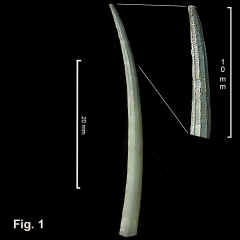|
|
DENTALIIDAE |
|
|
|
Paradentalium hemileuron (Verco, 1911) Description: Shape narrow, moderately curved. Weight moderately heavy. Aperture diameter up to 3.0 mm. Apex diameter 1.0 mm, polygonal, with small notch on ventral side Sculpture at the apex of 10–11 narrow ribs, which become obsolete at about half to two-thirds shell length; interstices wide. Transverse sculpture fine striae. Aperture circular. Colour white, opaque when dead, translucent and glossy when alive. Size: Up to 56 mm in length. Distribution: Global distribution unknown. Assumed to be endemic to Australia with a distribution from off Sydney, NSW, southwards and around southern Australia, to north-west of Rottnest Island, southern WA, including Tas. Habitat: Subtidal, down to 1463 m. Common. Lamprell & Healy (1998) report specimens from WA taken in a depth of 10 m, but in NSW the shallowest recorded depth is 274 m. Common. Comparison: Paradentalium hemileuron is similar to P. octopleuron in having a small number of strong axial ribs, but in P. hemileuron the ribs fade out in the middle of the shell, whereas in P. octopleuron they continue to the aperture. Synonymy: Dentalium tignum Colman, 1958 is a previously recognised synonym. Fig. 1: Off Sydney, in 384 m (C.172276). |
|
